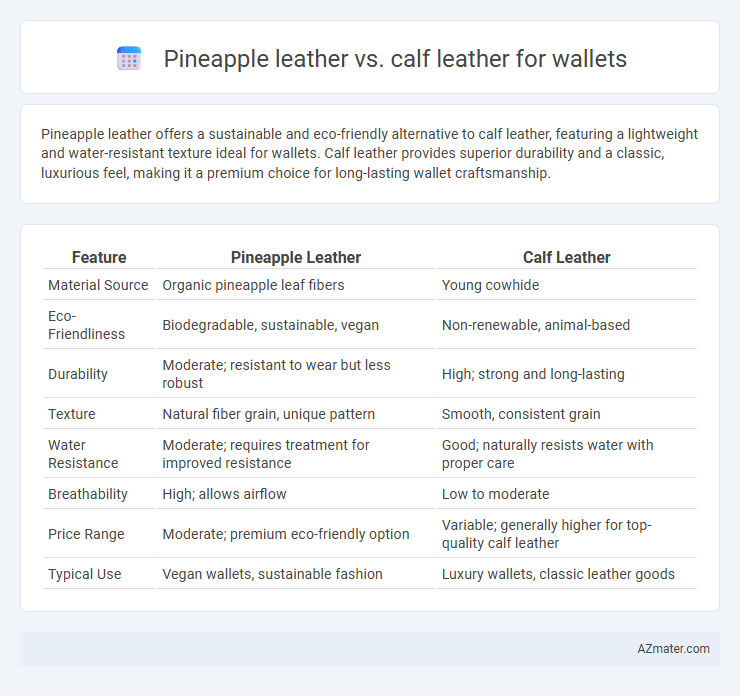Pineapple leather offers a sustainable and eco-friendly alternative to calf leather, featuring a lightweight and water-resistant texture ideal for wallets. Calf leather provides superior durability and a classic, luxurious feel, making it a premium choice for long-lasting wallet craftsmanship.
Table of Comparison
| Feature | Pineapple Leather | Calf Leather |
|---|---|---|
| Material Source | Organic pineapple leaf fibers | Young cowhide |
| Eco-Friendliness | Biodegradable, sustainable, vegan | Non-renewable, animal-based |
| Durability | Moderate; resistant to wear but less robust | High; strong and long-lasting |
| Texture | Natural fiber grain, unique pattern | Smooth, consistent grain |
| Water Resistance | Moderate; requires treatment for improved resistance | Good; naturally resists water with proper care |
| Breathability | High; allows airflow | Low to moderate |
| Price Range | Moderate; premium eco-friendly option | Variable; generally higher for top-quality calf leather |
| Typical Use | Vegan wallets, sustainable fashion | Luxury wallets, classic leather goods |
Introduction to Pineapple Leather and Calf Leather
Pineapple leather, also known as Pinatex, is an innovative sustainable material made from pineapple leaf fibers, offering an eco-friendly alternative to traditional leather. Calf leather, derived from young cattle, is renowned for its smooth texture, durability, and luxurious feel, commonly used in premium wallets. Comparing these materials highlights the environmental benefits of pineapple leather versus the classic strength and aging qualities of calf leather.
Material Origins and Production Processes
Pineapple leather, derived from the fibrous leaves of the pineapple plant, undergoes a sustainable process where pineapple leaf fibers are extracted, dried, and combined with non-toxic binders to form a durable, eco-friendly material. Calf leather originates from the hides of young cattle and is produced through a traditional tanning process that involves chemical treatments to preserve and soften the animal skin. The contrasting origins--plant-based for pineapple leather and animal-based for calf leather--result in distinct environmental impacts and production methods central to sustainability considerations in wallet manufacturing.
Environmental Impact and Sustainability
Pineapple leather, made from agricultural waste like pineapple leaves, offers a sustainable alternative to traditional calf leather by minimizing deforestation and reducing carbon emissions during production. Calf leather involves intensive livestock farming with significant environmental costs such as high water usage, methane emissions, and deforestation for grazing land. Choosing pineapple leather wallets supports circular economy principles and reduces reliance on animal agriculture, making it a more eco-friendly option in sustainable fashion.
Durability and Longevity Comparison
Pineapple leather, made from renewable pineapple fibers, offers impressive durability with resistance to scratches and water, making it a sustainable alternative to traditional calf leather. Calf leather, derived from young cattle, is renowned for its natural strength, flexibility, and ability to develop a rich patina over time, contributing to wallet longevity. While pineapple leather excels in environmental benefits and moderate wear resistance, calf leather typically outperforms in long-term durability and aging quality for wallets.
Aesthetic Appeal and Texture Differences
Pineapple leather offers a unique, eco-friendly texture with a slightly fibrous and pattern-rich surface that enhances the aesthetic appeal of wallets through a natural, artisanal look. Calf leather provides a smooth, supple feel with a consistent grain, delivering a classic, refined appearance favored in luxury wallets. While pineapple leather stands out for its sustainability and distinct texture, calf leather excels in durability and traditional elegance.
Comfort and Usability in Daily Life
Pineapple leather offers lightweight comfort and breathability, making it ideal for daily use in wallets, as it is soft and develops a unique patina over time. Calf leather provides durability and a smooth texture with higher water resistance, supporting long-term usability and maintaining structure despite frequent handling. Both materials ensure practical functionality, but pineapple leather emphasizes sustainability and a flexible feel, while calf leather prioritizes sturdiness and classic leather aesthetics.
Cost and Market Availability
Pineapple leather, an eco-friendly alternative, generally costs 20-30% less than traditional calf leather due to lower raw material expenses and simpler processing techniques. Market availability of pineapple leather wallets is rapidly expanding, driven by rising demand for sustainable fashion, though it remains less widespread than calf leather products, which dominate the luxury wallet segment with well-established supply chains. Calf leather's premium pricing reflects high durability and craftsmanship, maintaining strong presence in high-end markets despite growing interest in plant-based materials like pineapple leather.
Ethical Considerations: Animal vs Plant-Based
Pineapple leather offers an ethical alternative to traditional calf leather by eliminating animal exploitation and reducing the environmental impact associated with livestock farming. Made from natural pineapple leaves, this plant-based material supports sustainable agriculture and minimizes carbon emissions compared to the resource-intensive production of calf leather. Choosing pineapple leather wallets aligns with cruelty-free values and promotes innovation in eco-friendly fashion materials.
Maintenance and Care Requirements
Pineapple leather, a sustainable alternative made from pineapple leaf fibers, requires gentle cleaning with a damp cloth and avoids excessive moisture to maintain its texture and color. Calf leather demands regular conditioning with specialized leather creams to prevent drying and cracking, along with protection from prolonged water exposure. Both materials benefit from storage in a cool, dry place away from direct sunlight to prolong wallet durability and appearance.
Which Leather is Best for Wallets?
Pineapple leather offers an eco-friendly, sustainable alternative to traditional calf leather, boasting durability and a unique texture ideal for wallets. Calf leather remains prized for its softness, strength, and long-lasting quality, providing a classic, luxurious feel. The best choice depends on whether sustainability or traditional craftsmanship is prioritized for wallet materials.

Infographic: Pineapple leather vs Calf leather for Wallet
 azmater.com
azmater.com